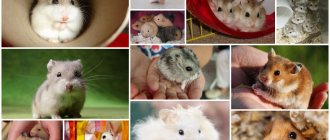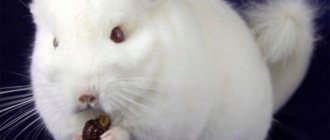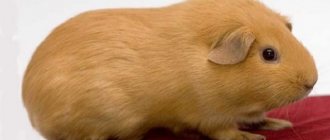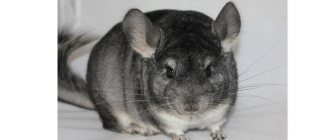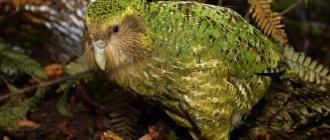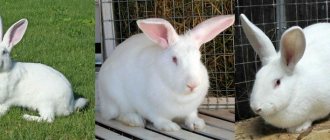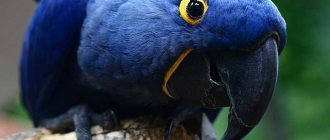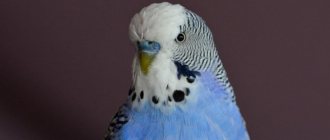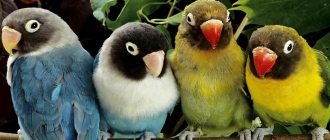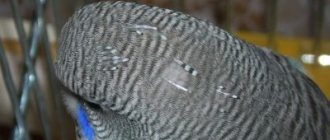- home
- Parrot
- Kinds
05/15/2019 Parrots are among the most ancient representatives of the fauna. The appearance of these birds has not changed from their appearance on the planet to the present day. United into one order, parrots have many differences from most birds. Parrots of all varieties are characterized by such characteristics as attractive appearance, beautiful plumage and color, sociability and learning ability, liveliness of character and unpretentiousness in care and maintenance. Thanks to these and other characteristics, parrots quickly gained popularity as pets. What kind of parrots there are and what features different types of these birds have will be discussed in this article.
Luxurious barraband parrot
It is also called barrabantine by another name. He lives in the eucalyptus forests of South-Eastern Australia. The body reaches 40 centimeters in length. The color of the main plumage is bright green, the throat and forehead are yellow.
In Europe and America it is often found at home. Speech abilities are below average. With proper organization of classes, he can learn to pronounce a few words, copy the sounds of other birds and domestic animals, and simple melodies.
Philippine cockatoo
Representative of the cockatoo species. Lives in the Philippine Islands. Prefers to live in the hollows of tall trees. Has a white color. The body length reaches 32 centimeters, and the weight reaches 300 grams. Has a high life expectancy - up to 50 years. Despite this, it is not of particular interest to most amateurs, since it is incapable of learning to talk.
Nestor
This species of parrot is an ancient inhabitant of New Zealand. Nestor is strongly built and comparable in size to a crow.
One of the subspecies - kaka - is an inhabitant of mountain forests. These parrots have a lively and sociable character and make a lot of noise. The kaka tongue is well developed and adapted for extracting nectar from tree flowers. These birds love to eat berries, seeds and larvae of harmful insects. The parrot extracts the latter from under the bark of trees, plucking out affected areas of wood.
Another representative of the nestor species is the kea parrot. Such birds live in high mountains. They feed mainly on berries of various trees, honey, roots and insects. It is believed that kea can attack flocks of sheep and pluck small pieces of meat from the backs of the animals.
Collared Parrot
One of the representatives of Barraband parrots. Lives in Australia. Height reaches 37-38 centimeters. Just like the rest of the squad, it is painted green. He loves to fly. Therefore, when kept at home, it requires equipment and a fairly spacious place to keep it, which not every amateur can afford.
Under natural conditions, these birds eat on the ground. When kept in captivity, they do this on the floor of a cage or enclosure. They first scatter food from the feeder, and over a fairly large distance. This means that bedding must be provided on the hard floor, and the area must be cleaned frequently.
Parrot - care and maintenance at home
Parrot selection
When buying a parrot, the first thing you need to pay attention to is age. Young parrots get used to new conditions more easily, are tamed faster, are most often more capable of learning, and are easier to produce offspring from.
Healthy parrots always have elastic, fast movements, plumage that fits tightly to the body, lively, shiny eyes and breathing without wheezing or whistling sounds. It is not recommended to buy parrots that have noticeable violations of these signs. Also avoid buying a parrot with bare areas, this means that the parrot has a tendency to pluck itself.
Transporting a parrot
To transport parrots over a short distance, a special transport cage is required. The size of the transport cage depends on the distance over which the parrot is transported and its size.
If transportation will last more than 3 hours, then a feeder and an automatic drinker must be placed in the cage. When transporting a parrot for more than 2 days, the transport cage should be of a size familiar to the parrot, as if it were living at home.
Parrot cages
Regardless of whether your parrot is kept in an aviary or in a cage, it should be spacious!
Your parrot's cage should not only be spacious, but also easy to maintain and made of non-toxic material. It is best to choose a cage with metal bars, since a bird with its strong beak will most likely chew a cage made of wood, and various parasites may appear in it.
It is best to take a square or rectangular cage. Round cages, of course, look very beautiful, but in such a cage the parrots are more susceptible to stress, since they will not have the opportunity to hide in a corner. In addition, they are very inconvenient to maintain.
The cage should have a high tray where sand can be poured, and besides, the presence of a tray will prevent the food from spilling. The cage should have perches and rings. Perches are best made from hardwood tree branches so that the parrots can chew on them.
The thickness of the perches is of great importance; they should all be different in diameter (from 2 to 12 cm).
In nature, parrots constantly climb branches of different thicknesses, and perches of the same thickness are less comfortable for birds, because their toes are in an almost static position. The cage should be spacious enough for the parrot to freely spread its wings. A padlock must be placed on the cage door. It is better to choose medium-sized feeders and drinkers; the shape does not really matter, the main thing is that it is stable enough. They should also be made of non-toxic materials and not have sharp edges.
Most parrots love to bathe, so it is best to attach a special bath to the cage. Preference should be given to a bath whose bottom is slightly rough; in such a bath the parrot will probably not slip.
Choosing a place for a cage with a parrot
The place where the cage is installed should not be noisy (not located in the aisle, away from speakers and TV). You should not place it close to the window, so that the parrot does not get drafted and does not constantly stand in the sun. It is best to install the cage in a calm, bright place near the wall, so that a suddenly frightened parrot can fly to the wall and feel protected. The cage, depending on its size, can be installed on the floor, hung on the wall, or placed on a special stand. It is advisable for parrots to be in complete darkness at night.
Cleaning a parrot's cage
The cage must be kept clean. The cage and perches need to be cleaned every day or every other day. Feeders and drinking bowls should be washed with hot water every day. The drinking bowl should be wiped clean with a clean towel to avoid the formation of mucus on the walls of the drinking bowl.
Effect of sunlight on parrots
Sunlight is essential for the health of a parrot; if the bird receives the right amount of light, it will grow and develop properly.
In the summer, the parrot's cage must be placed outside for a short time so that its body receives ultraviolet rays. At the same time, there should be shaded areas in the cage so that the bird can hide from the sun. To keep a parrot, it is better if the amount of sun is evenly distributed throughout the year, so in winter, when daylight hours are shorter, artificial lighting is necessary.
The bird should be in the light 14-16 hours a day.
Humidity and air temperature in the room where the parrot is kept
Most parrots do not tolerate changes in temperature and humidity very well, so it is important to maintain stable conditions in the room. For parrots kept in cages, the optimal temperature is considered to be 18-20 degrees. The relative humidity level for parrots should be approximately 60-70%. It is advisable to install a humidifier and air conditioner in the room with the cage.
Stress in parrots
The cause of stress in a parrot can be any sudden change in the external environment, and this can lead to the death of the parrot.
Possible causes of stress:
- sudden change in microclimate;
- prolonged fasting;
- a sharp change in the usual diet;
- cell movement in space;
- insufficient area for movement;
- insufficient number of toys;
- unexpected capture of a parrot;
- sudden bright light or loud noise.
Young parrots are more susceptible to stress; their acquisition itself is often accompanied by stressful situations (street noise, change of environment, new owner). Adult and well-tamed parrots are almost not subject to stress, and this condition occurs very rarely in them.
Remember - all changes in your parrot’s life should occur gradually and then he will be healthy and friendly.
Small parrot-vase
Under natural conditions, these birds live on the islands of the Indian Ocean - Madagascar and the Seychelles archipelago. Their height reaches 36 centimeters and their weight is 315 grams. They have a characteristic black-brown color. During the day they break up into racks of 10-15 individuals, and towards night they gather in large groups of up to 200 individuals. Despite the fact that in the wild they are very cautious and do not let people get close, at home they make contact quite easily and are amenable to training. But to achieve results, you need to work with them constantly.
Character and lifestyle of the white cockatoo
The white cockatoo can be called a social bird and is naturally very cautious. In order to notify the flock of a threat, it makes sounds or knocks its beak on dry branches.
Individuals often live in pairs and during the day they raid corn crops. If there is little food, they can migrate over long distances. They love mangrove forests, swamps, clearings, and farmland.
White cockatoo parrots are true acrobats; in addition to copying sounds, they repeat movements. They are especially good at flips and jumps. By the way, they can shake their heads for a very long time, while making all kinds of sounds.
Congo parakeet
These African parrots are found in the western and central parts of the continent. Their physical characteristics are as follows:
- Body length up to 29 centimeters.
- The main color is green.
They are divided into three types - large, small and black-winged.
Can be successfully kept in captivity. They copy the sounds of other birds and animals and musical melodies well. The ability to reproduce the human voice is usually poorly developed. But some birds, after persistent and regular training, had a vocabulary comparable to gray parrots. This is especially true for individuals born in captivity.
How much does a parrot cost and what does the price depend on?
It is definitely impossible to answer the question of how much a parrot costs - there are several criteria that make up the price:
- The first thing you should pay attention to when choosing a parrot is size. The larger the bird, the more expensive the price.
- The second is the ability to copy human speech. Therefore, when you find out how much a talking parrot costs, you will be faced with the fact that they cost more than those that speak only their own language.
- The next thing is the appearance, since some are valued higher.
- And finally, the last and most important thing is the availability of documents. And here we are not so much talking about confirming the authenticity of the species, but rather the fact that the bird was brought legally, which means that customs duties were paid for it, and veterinary certificates were issued indicating the health of the parrot. Accordingly, illegally imported birds will cost less, but you will not be sure whether they are healthy or okay. So, its treatment can take a lot of money and time, and the low price at the time of purchase will not be justified.
If the cost of the imported bird seems high to you, then you can purchase a parrot from a nursery. He will also have the appropriate documents and you will not have to worry about his health.
In a pet store or from a private owner
When choosing a parrot, the place of sale is important. The easiest way is to buy a bird in a store. Such a pet will have the necessary documents, including a veterinary certificate. But if you choose a parrot of a non-common breed, then it is better to visit a pet exhibition and take a closer look at your future pet. At exhibitions you can meet breeders and then buy a pet directly.
You can also buy a parrot at a nursery. Here it is worth paying attention to the ring on the paw - it is put on the chicks at birth and remains with the bird for life. These parrots are also called “foster birds” because they are literally hand-fed.
Parrot in a pet store
The Internet is now replete with advertisements for the sale of birds of any kind. Comparing how much parrots cost in a pet store and from private owners, we can definitely say that it is cheaper to buy second-hand, but there are dangers. At the very least, they can offer you a healthy bird without documents, or perhaps the former owner wanted to sell it due to illness. If you buy a parrot from an advertisement, be sure to show the bird to a veterinarian and make sure that it is absolutely healthy.
Adult bird or chick
What age is best to take a bird?
If we are talking about small or medium-sized individuals, then it is better to take a younger parrot - it will quickly adapt to new living conditions and get used to its owner and environment. The optimal age for buying a parrot is from 1 to 3 months . It is at this age that the chick already eats food on its own, it does not need to be warmed, since it has feathers and has already flown out of the nest - basically, these parameters indicate that the parrot is ready for life without its parents.
If a chick is bought for the purpose of breeding, then it is better not to take it away from its parents too early. Since the chicks learn from their parents, look at the “family model”, copy the care of future babies, and subsequently it will be easier for them to raise their offspring.
Parrots such as cockatoos, macaws, and grays, which are considered large birds, are best purchased upon reaching maturity. They will already be well built and will be able to give birth to offspring. But such species require a spacious room, large cages and more careful care.
Adult macaw parrot on hand
How does the rarity of breed and color affect the price?
In the wild, there is not such a variety of parrot colors as in artificially bred species. For example, budgerigars have green plumage, which allows them to hide in the foliage of trees. But during the breeding process they become both blue and white, and you can also find very rare colors. Of course, such parrots will cost more due to their attractive appearance.
The rarity of the breed will also affect the cost. For example, Kramer's necklace parrots are valued higher than budgies or lovebirds, and will cost from 9,000 rubles.
Onomatopoeic ability
Talking parrots have always been more popular than their feathered relatives. It is worth understanding that such birds do not immediately learn to speak; here it is necessary to work with the bird, train it, so a talking parrot is more expensive than a regular one. True, there are cases when rare and beautiful birds are valued higher.
The most common type of parrot capable of onomatopoeia is the Gray. He is recognized as the most trainable and most accurately copies human speech. Amazons are also easy to train, but they do not pronounce sounds as clearly as Grays do. Speaking parrots also include cockatoos, macaws, eclectus and others.
Remember that “talkers” require special attention; you need to constantly talk to them in order to strengthen their skill.
Video: How to choose a talking parrot
Woodpecker parrots
The smallest representatives of the family. They live in the tropical forests of the island of New Guinea. Their size does not exceed 10 centimeters in length. They can be distinguished from other small birds by their strongly curved beak.
It is very difficult to keep them in captivity, since they:
- They love to fly and cannot stand being in a cage for long periods of time.
- They need special food, the basis of which should not be grain mixtures, but fruits and berries.
Animal in the Moscow Zoo
The Moscow Zoo has kept large white cockatoos for a long time. Currently, a pair of cockatoos lives in the Birds and Butterflies pavilion on the New Territory of the zoo. To prevent these smart birds from getting bored, tree branches are periodically placed in their enclosure, which they happily pluck. For climbing, ropes are hung in the enclosure; cockatoos not only climb on them, but also pinch them. Their beak is very powerful, they are able to crack nuts with their beak and bite off branches as thick as a finger!
The cockatoo is fed with a special grain mixture and given nuts - walnuts, hazelnuts, pine nuts and peanuts, and seeds. Parrots get a variety of fruits: bananas, papaya, avocados, oranges, pomegranates, etc.
Headed lettuce is hung on the branches for them. Cockatoos love fresh corn. In the summer, the zoo buys corn on the cob; the cobs are frozen and given to the parrots in the winter, after they have been defrosted.
During the period of feeding the chick, baby food - milk porridge - is placed in the cockatoo's enclosure. The cockatoos appreciated this help, because now they do not have to process solid food for the chick and regurgitate it, the porridge is already ready for consumption.
Our cockatoos are very caring, loving parents. Using a camera installed in the nest, we were able to spy on their family life. They take care of their offspring together. The chick sits in the nest for three months. Parents “lick” their child so thoroughly that by the time it leaves the nest it looks plucked.
Corella
Parrots are very popular among amateurs due to their unpretentiousness and ability to learn speech. In natural conditions they live in Australia. Their main color is dark gray. The cheeks, forehead and crest are yellow. It is the crest with its long feathers that distinguishes the beauty of the cockatiel among other parrots. Their weight reaches 100 grams and their length is 33 centimeters.
Cockatiels are characterized by mutations. Therefore, many birds have a color different from the main one. Pearl cockatiels look especially attractive.
Coral
Pearl, otherwise pearl cockatiels are characterized by an attractive pattern on the wings and back. It is formed due to light spots. It is these spots of different sizes that form a bizarre composition, so beloved by many connoisseurs of parrots.
Nutrition and feeding behavior
Cockatoos feed mainly on a variety of plant foods. They eat the fruits of various trees (papaya, durian), enjoy eating nuts, corn grains, as well as mushrooms, insects and their larvae, etc. Flocks of cockatoos can cause significant damage to agricultural crops, especially corn.
In the first half of the day, a flock of cockatoos feeds, carefully observing what is happening around them. Any event causes a lively reaction, especially if another flock flies past. Its passage is accompanied by loud cheers.
Having had their fill, around noon, the cockatoos fly away to their resting place, and for a while everything around becomes quiet. Having rested, the birds go back to feeding.
Green-cheeked red-tailed parrot
Under natural conditions, these birds live in Brazil, Bolivia and Argentina. Their colors consist of dark gray-green tones. Height reaches about 25 cm, and weight up to 70 grams. Quite often found among home breeders. This is due to their playful and gentle nature, as well as quite good intellectual abilities. They can learn to pronounce some words.
Budgerigar
Perhaps the most common feathered pet among home lovers. Its popularity is due to objective reasons:
- Unpretentiousness in content. Even a child can handle the care.
- Good abilities. A budgie can learn up to 150 words.
- Pleasant character.
- Relatively cheap, especially in comparison with exotic birds.
The average height is 17-20 centimeters, body weight 40-45 grams. The main color is grass green. Life expectancy at home on average reaches 10-15 years.
Jaco
Perhaps the most intelligent parrot, easy to train and capable of learning several hundred words. The Gray's modest gray coloring is more than compensated by his phenomenal talent for onomatopoeia. The ash plumage of the body is diluted with a red or brown tail, a whitish mask on the head, and a black and very impressive beak.
Jaco is a long-liver; there are cases when the bird’s age was 50 years. On average, a tame parrot of this species lives 35–40 years; in nature, this period is much shorter due to many dangers. If you intend to get yourself such a pet, get ready for the difficulties of keeping a large bird. Not only is the cost of Grays in poultry markets and nurseries simply off the charts, but home improvement and high-quality feed will not be cheap.
For a smart bird, a person must become a friend; now not a single activity can be done without the participation of a bird. Maintaining your Gray's positive mood will be successful if you provide him with new toys, teach him tricks, and offer him various tasks. A parrot, left to its own devices, will begin to damage and destroy furniture and scatter garbage. A bored bird from idleness will begin to pluck itself, which will lead to serious illness.
Macaw
According to many, these are not only the largest (up to 95 centimeters in height) but also the most beautiful parrots in the world. They live in South America. Their colors are stunningly bright and consist of red, yellow, green and blue tones. At home, they are very rare, because:
- They are very expensive.
- They require spacious cages and enclosures.
- They have a complex character.
Characteristics and features of parrots
A characteristic feature of parrots is their bright colors, long crests and tails. The movable strong beak of a parrot serves not only for eating, but also for defense and movement along tree branches. The singing of parrots has individual characteristics and also depends on the character and mood of the pet.
By nature, parrots are quite friendly, sometimes they show themselves in a very funny and funny way, surprising others. These birds require proper care and treatment; they cannot tolerate loneliness and begin to show whims. Pet parrots can be noisy and create chaos in their cage.
Kalita or monk parrot
The bird got its name due to the similarity of its color to the cassock of Capuchin monks. Its plumage is green, and its breast has a special, pale greenish-gray color, with green stripes crossing it. It lives in the countries of South America - Uruguay, Argentina, Paraguay, Bolivia. Its weight reaches 100 grams, and its height is 30 cm.
Kalitas are very active, sociable and inquisitive. They get along well with people when kept at home. They learn to speak relatively well. Their vocabulary reaches 100-200 words. But these parrots scream very often and loudly, which can cause serious inconvenience.
True parrots (tribe)
This tribe of birds is very numerous. It has more than 70 genera. Its representatives live in Australia, New Zealand and the Pacific Islands. The most famous tribes among bird lovers include:
- Red-winged parrots. They include two species - Timor redwings and common redwings. Body length reaches 33 centimeters. They got their name due to the red color of the front part of the wings. Popular with collectors.
- Royal. They include three species - amboinsky, yellow-shouldered and king parrots themselves. The back and wings of these birds are green, and the breast is red. Due to their beauty, they can often be found in poultry houses. They are relatively easy to learn, but rarely master human speech.
- Luxurious. Also included are three species, of which the most popular among home breeders is the luxurious mountain parrot. Its color scheme is characterized by an overwhelming predominance of bright yellow shades. Birds grow up to 40 centimeters. They can often be found in captivity. They tolerate low temperatures well, so in regions where there are no severe frosts, it is preferable to keep them in outdoor enclosures. Birds scream often and loudly, which sometimes causes inconvenience.
Kakapo
An unusual and rare parrot from New Zealand, the kakapo species, has a head structure that resembles an owl, hence its second name - owl. This is a very interesting, even unique species of parrot: it does not fly due to weak wings, it is nocturnal, females are half the size of males. The kakapo's voice resembles both the croak of an owl and the grunting of a pig.
The inability to fly does not mean that this parrot cannot climb trees: its heavy beak and dexterous wide paws with claws help it get food and escape from predators. They descend from a tree in a jump, balancing with the help of their wings. To minimize threats, the kakapo stays in its burrow during the day and goes out at night to search for food. In the dark, he is well oriented by smell; vision is not so important to him.
The color of the feathers was created by nature for better camouflage: dark green with brown and black specks.
Now this species is disappearing, kakapo parrots are under protection, so zoos cannot boast of the presence of a rare individual. The living conditions in the apartment are completely unsuitable for such an exotic bird. Birds do not reproduce in captivity, so the chicks are bred on farms, raised and released on the islands. Scientists are trying to increase the population without allowing the species to go extinct.
Ruffled parrot
It is one of the most popular parrot species among home breeders due to its beautiful appearance and ability to reproduce human speech. In natural conditions, it lives in the countries of Africa and South Asia. Often lives near people. The main color of the coloring is green. Adult birds are up to 42 centimeters tall and their weight reaches 140 grams.
Jumping parrots
A genus, numerous representatives of which live in Australia, New Zealand and nearby islands. There are 10 types. Its representatives are otherwise called kakariki. Their main color is green. They prefer to settle in the lower tier of the forest and look for food on the ground. They are frequent inhabitants of apartment cages and enclosures. They sing very well and are well tamed, but teaching them to pronounce simple words can only be done with great difficulty.
Major diseases of the White-crested Cockatoo
The most common diseases in Alba parrots: self-plucking, physical trauma, sacrocystosis, fatty hepatosis, obesity, infections of bacterial or fungal origin, food intoxication, cloacal prolapse, ornithosis.
At the slightest suspicion of illness, the parrot needs to be shown to a veterinarian.
Prevention of many of the above-mentioned diseases is the proper care of the bird’s home.
Recommended:
- clean the feeders and drinkers daily and wash them well;
- washing poles and toys as they become dirty (if they lose functionality or are damaged, replace them with new ones);
- washing the cage once every 7 days, followed by ongoing disinfection;
- complete disinfection of the parrot’s housing and equipment once a year.
Video: Cockatoo Parrot Panic
Noble green-red parrot
In the wild it is found in northern Australia, the Moluccas and Solomon Islands, and New Guinea. A very beautiful bird. Characterized by a sharp difference in the color scheme of males and females. Boys' main color is green, while girls' main color is cherry-red. Due to their aesthetic appearance, they are popular among lovers of feathered pets. They have a calm, even phlegmatic character. In captivity, life expectancy can reach 40-50 years. They are relatively well tamed, but extremely rarely master the ability to pronounce words.
Ringed varieties
There are 12 species of these parrots in nature. Found in southern Asia and East Africa. These are elegant, graceful birds. The body size reaches 42 cm. The neck is surrounded by a stripe in the form of a necklace or tie. Having short, weak legs, birds actively use their beaks to move.
They are well tamed and can reproduce several words and even phrases. They can be loud, but this deficiency can be corrected by education.
Lorikeets
About a dozen species of lorikeets are found in the mountain forests of Australia and Indonesia. The body length of the birds is 20-30 cm. The color of the plumage is green, complemented by red, blue or yellow, depending on the breed.
Ringed lorikeet parrot
They are well tamed in captivity. The basis of the diet is the seeds of various herbs. Be sure to treat your pets to apples, berries, citrus fruits and herbs. When bred at home, they can produce offspring.
Corella
A medium-sized parrot, the only representative of its genus. In nature, it inhabits the Australian continent. Characterized by the presence of a long yellow crest and a straight, pointed tail. Breeders managed to develop various color combinations of birds in gray, yellow and beige tones. The cockatiel's cheeks have bright red spots.
Corella is a ringed parrot species
They are well tamed, capable of learning individual words, whistling melodies and performing tricks. They feed on grain mixtures, love sunflower seeds, and can enjoy fruits.
Monk (Quaker, Kalita)
The Quaker or monk parrot is native to Brazil, Argentina and Uruguay. Birds live on the treetops of savannahs. The only members of the family that build large nests.
Parrot monk
It is a medium-sized bird of gray-green color with white tips and blue wings, as well as a bluish forehead. The coloring resembles the robe of Quaker monks, which is why the parrot gets its name. The body length of a Quaker is 30 cm. In captivity they bear offspring.
Kalita are good talkers; they can memorize several dozen words and even call people by name. Cheerful, sociable birds are very energetic, love to play and are good at learning tricks.
Rosella
Bright, showy parrots with a gentle voice and pleasant singing come from Australia. The body length of the rosella is 25-35 cm. The cheeks are decorated with spots of yellow, blue or white. The color of the plumage is variegated.
Rosella parakeet
The ability to imitate speech is small, but your pet can be taught to sing beautiful melodies. They are tamed quickly, have a calm disposition and a gentle voice. However, they can behave aggressively towards their relatives.
Read also
Rosella parrot care and maintenance
It is advisable for birds to install a bathing suit, as they really love water procedures. They are unpretentious in food. They breed in captivity.
Lovebirds
The genus includes 6 species of small, brightly colored parrots found in Africa and Madagascar. Lovers also have the rosy-cheeked lovebird. The bird's plumage is predominantly grass-green. The front of the neck and cheeks are pink, the forehead is bright red, and the beak is straw yellow.
The body length is no more than 17 cm. They have a short tail, as well as a large head and a thick beak.
They are monogamous and pair for life. However, after the death of a partner, they can create a family with another individual.
It is worth taking into account the aggressiveness of birds towards representatives of other species and keeping them in a separate cage. These are graceful, graceful birds. It is a pleasure to watch such pets. They reproduce well in captivity.
grass parrots
Small Australian parrots with beautiful plumage and a melodious voice. Body length does not exceed 21 cm. Presented in six types.
grass parrot
Feathered birds are slender, elegant, and graceful. They don't talk, but they sing very pleasantly. In the wild, grass parrots feed on grass seeds, juicy fruits, and vegetables.
Senegal parrot
This is a species popular among breeders, measuring 22-25 cm. The birds inhabit the forests of western Africa. The predominant color is green. The head is gray, and the abdomen is yellow to orange.
Senegal parrot
They are well trained and extremely playful. Representatives of the species can be taught to pronounce a few words.
Read also
Senegal parakeet
Eclectus
Eclectus is also called the noble parrot. A bright, showy and intelligent bird. In nature, it inhabits palm and deciduous forests of the Maluku, Chinese, Guinea, Solomon Islands, and Australia. The body size can reach 45 cm. The tail is square-shaped and short. Sexual dimorphism is clearly expressed in plumage color: females are predominantly red-blue, and males are green.
Eclectus parrots
They are distinguished by a very affectionate character and deep affection for humans. They can be taught to talk, whistle tunes, perform tricks and magic tricks. The intellectual abilities of birds allow them to pronounce the right words in place, and even clean the cage, returning toys and food to their place.
Amazon
The most popular parrots for home keeping are large parrots. They have a friendly, calm character. Amazons are highly trainable and can pronounce about 80-100 words, depending on the subspecies.
Amazon parrots
The following species are considered to be the most capable of training and imitating human speech:
- yellowhead;
- white-headed;
- Blue-fronted Amazon.
In the wild, they inhabit the forests of the Amazon River basin, South and Central America. Species measuring 30-38 cm are more common on the market. The body is dense, the beak is strong and of moderate length. The plumage color is mainly green, with red spots on the head, tail or wing. In captivity they practically do not reproduce.
Macaw
The largest representatives of the order, the Macaw or Arara, share the same habitat with the Amazons. These are luxurious birds with bright colors in green, yellow, blue and red. The tail is long, straight, pointed. The body can reach 90 cm. Ararauna, maracana and green-winged macaw are more common in captivity.
Macaw parrot
Birds have relatively little ability to speak, but they can remember individual words and learn entire phrases. However, when purchasing a pet, you need to be prepared for their shrill, loud cry. They are smart and master various tricks very well.
But keeping arar for children is not recommended; during the mating season, massive birds can become dangerous. Macaws do not breed in captivity.
Aratinga
In captivity, the most common species are the sunny aratea and the endaya. The body length of the birds is about 30 cm. The color of the plumage is mainly bright yellow interspersed with blue and green colors.
Aratinga parakeet
They feel more comfortable in an enclosure, especially during breeding. From chick age they are well tamed and trained. Conversation ability is low. They are noisy, which makes them poorly suited for apartment living.
Ribbon parrot
Representatives of this species are otherwise called tiger parrots. They live in New Guinea and Indonesia. This species has 4 subspecies. The maximum body length of these birds varies from 12 to 23 centimeters, and weight from 90 to 150 grams. Their main color is green, with characteristic black stripes on the back. Thanks to them, they were nicknamed tiger.
These birds are rarely found in apartment conditions. The reason for this is objective - the average life expectancy in captivity is no more than 3 months. They cannot reproduce in a cage or enclosure. Scientists have not yet been able to determine the cause of these phenomena.
Lovebirds
These birds of African-Madagascar origin live in pairs and never move beyond earshot of their mate. It is highly not recommended to have one lovebird. Even if you give him maximum attention, he will still be sad and will not live long.
Many people believe that lovebirds are medium-sized parrots, but it is still more correct to classify them as small varieties. In size they reach 17 cm.
One of the differences between these birds and other species of parrots is that they have a short tail. Therefore, their size is determined by the length of the body. Another characteristic feature of birds of this species is their long beak, extended towards the bottom.
The physique of lovebirds is harmonious, and the plumage has bright contrasting colors. Parrots are colorful and elegant - nature has generously rewarded them with attractiveness. Different combinations of colors in their colors are possible. Most often in their plumage there are various shades of the following colors:
- green;
- red;
- orange;
- pink;
- blue;
- black;
- white;
- grey.
However, the “riot of colors” extends not only to the plumage. Lovebirds with lilac, green or red beaks are often found.
These cute couples are considered one of the most arrogant and impudent parrots. They rarely get along with other pets. These birds are different:
- glibness;
- loudness;
- curiosity;
- agility.
Talkativeness is not typical for lovebirds. Vocabulary – 10–15 words.
fan parrot
Its natural habitat is the northern part of Latin America. The bird's height reaches 35 centimeters. The plumage is green. The breast is dark red, with pale blue splashes. Well suited for home maintenance thanks to:
- Calm character.
- Attachment to people and the possibility of quick taming.
- High life expectancy in captivity, which reaches up to 40 years.
Song breed of Rosella parrots
The cute Australian rosella parakeet does not speak, but sings – melodiously and pleasantly. The bird's voice is beautiful, expressive, and his manner of performance is calm. By nature, Rosellas are calm and friendly. But they will not be able to get along in the same cage with a bird of a different species - the sharing will end in a fight.
Rosella has average dimensions - 20–30 cm. The colors of the plumage are varied. Most individuals can be divided into two categories - those with a pale yellow head or those with a red head.
Lorikeets
The habitat of numerous representatives of this genus is Australia and the islands of Oceania. There are 7 types. Of these, collectors liked the colorful lorikeets the most. They are characterized by bright, multi-colored colors. This is due to the fact that parrots feed on the nectar of flowers and with such colors it is easier for them to camouflage themselves from enemies.
At home, the piercing, creaky cries of these parrots sometimes cause inconvenience. There is only one way out of the situation - to teach your pet to speak as soon as possible. A lorikeet can remember up to 70 words.
They love to fly. They feel bad in cramped conditions. Therefore, the cage must be spacious. But the best solution would be to equip an enclosure.
Laurie
Capable, handsome Lories have, they can repeat up to 70 words themselves, up to 35 cm. A small red beak, there are 62 species.
On average, Loris live up to 20 years.
They are found in Australia, the Philippines, and the forests of Indonesia.
They gained the reputation of “screamers and slobs.” They throw food around and shout in a shrill, squeaky voice.
Droppings and food debris around the cage will have to be removed every day.
Unusually varied bright colors, but demanding temperatures of +20o C.
But Lories are peaceful, love children, will never harm them, and do not bite.
Aratinga
This genus includes 22 species of birds living in Latin America. All of them are relatively small in size - 25-35 centimeters in length. They have a very beautiful color. But the main reason for the popularity of arating among poultry keepers is not in it, but in the character of these birds.
They are very sociable and friendly. They willingly come into contact with all members of the owner’s family. Often people choose their favorite and become very attached to it.
They reproduce musical melodies well. They remember words quite poorly. Their vocabulary includes no more than 20 words.
The highlight of these birds is that they can learn to dance. They do this so touchingly that they cause friendly laughter from the whole family and its guests.
What to look for when buying a parrot?
If you have decided on the breed and type, as well as the place where you purchased the parrot, then you can start looking.
When purchasing, it is important not to miss a few points and pay special attention to:
- documents (medical and others (for imported birds));
- origin of the bird;
- health status;
- floor;
- ability to live alone;
- learning and training.
Now let's take a closer look at what the seller should provide you with when buying a parrot.
Availability of documents
When buying a parrot, you must remember that a conscientious seller must provide at least a veterinary passport for the bird. Also, if a pet is purchased for breeding, some sellers do a genetic test to determine the sex of the bird. This is necessary to distinguish a female from a male, since in some species of parrots this is not always possible by eye.
When purchasing poultry brought from abroad, the package of documents will be wider.
It is necessary to remember what the seller must provide when offering to buy foreign birds:
- CITES document;
- vet. certificate from the exporting country;
- vet. certificate issued upon entry;
- analyzes in duplicate (from the exporting country and the receiving country);
- permission from Rosselkhoznadzor to import poultry;
- registration in the Argus system.
Video: How to choose a healthy parrot
Even if at first glance such a bird has everything in order with its documents, it may turn out that the documents are fake, so be sure to check their authenticity.
Origin of the bird
Most parrots sold in Russia are raised in nurseries or at home. But rarer species are brought from abroad. Not all parrots come to us legally, so you need to carefully look at the documents confirming the origin of the bird. Especially often, such feathered pets are sold second-hand. Inexperienced buyers may fall into this trap and buy the wrong breed.
Parrots raised in nurseries must have a permanent leg ring. The origin of such birds is easy to prove.
Health status
Before purchasing, the bird must be visually inspected. Even if you are provided with veterinary certificates confirming that the bird is absolutely healthy, do not buy just by looking at the photo. Unscrupulous sellers may falsify medical documents, or the bird may be healthy at the time of medical examination, but become ill before sale. Therefore, also pay attention to the date of the professional examination.
If you have any doubts, you can consult a veterinarian specializing in birds before purchasing. A conscientious seller will not interfere with this, and you, in turn, will receive a completely healthy pet.
Gender, ability to live without a partner
When purchasing, pay attention to the gender of the bird.
Not all parrots can live alone. For example, when purchasing an adult lovebird, you need to buy him a pair. If you buy a very small chick, then in most cases he will get used to it and will be able to live alone, provided that the owner spends a lot of time with him.
Learning ability
Most species of parrots can be taught tricks and onomatopoeia. This is mainly why they love parrots. But some breeds learn faster, such as Grays, while others take a long time to start talking. In any case, you need to deal with the bird, talk to it, pay attention to it, otherwise you can easily go from the category of a beloved owner to an enemy.
Kea
Kea mountain parrots live in New Zealand. These are the only members of the family capable of reproducing and living at an altitude of 1500 meters or more. In wild conditions they often strive to live near people, whom they are often not at all afraid of. They are extremely inquisitive. In captivity, they are very well tamed and quickly get used to humans.
How many species of parrots are there in the world? More than 300. The article reflects information about only some of them. When choosing a feathered pet, you should study in more detail information about its biological species and recommendations for keeping it at home. If the lover follows the rules, the pet will turn into a devoted friend and will decorate the house for a long time.
Previous
All typesTypes of parrots for home keeping
How many species of parrots are there in the world?
Parrots, representing the order of the same name, are divided into two families:
- parrots;
- cockatoo.
In total, there are almost four hundred varieties of parrots in the world. These birds have both similar features characteristic of most birds of the order Psittacidae, as well as distinctive features inherent only to a particular species.
All parrots have:
- curved beak (or crossed);
- four toes on each paw, divided in pairs (two pointing back and two pointing forward).
Based on color, parrot varieties come in two types of plumage:
- bright or contrasting;
- camouflage.
In terms of size, parrot species differ significantly from each other. The sizes of birds of various breeds range from 8 cm to 1 m.
It is impossible to describe all breeds of parrots. But in order to partially appreciate the diversity of varieties of representatives of this order, it is worth taking a closer look at the most popular and widespread, famous and rare, remarkable breeds of parrot.
